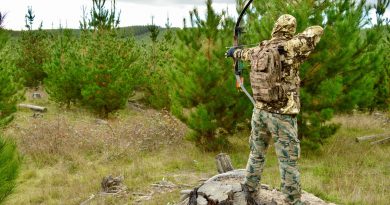Hunting by the Map
In the Allegheny National Forest, the United States Forest Service is confronted with the problem of supporting an unbalanced sex ratio in the deer herd on an overbrowsed range. Under an archaic buck rule only a distressingly small percentage of the deer population contained within the boundaries of the forest is legally huntable during the open season, and the big management problem centers around an inadequate harvest of the deer. Poor hunter distribution, which results in a large concentration of hunters in some areas and too few in others, is also a serious problem wherever deer hunters take to the woods; and on the Allegheny National Forest despite relatively flat topography, an adequate road system, and miles of pipe line and power line rights-of-way to hike over, hunters tend to remain near the highways and seldom venture into the back country. As a result, the harvest of deer is not uniform throughout the forest. In the State of West Virginia, Game officials report that hunters crowd certain portions of the range, while other areas where hunting conditions are equally good are ignored.
Unfamiliar terrain and oft told tales of “lost” hunters makes the average person wary of losing sight of the highway and his parked car, or leaving the valley in which his camp is located. Few hunters have taken the time or made any effort to learn to use a compass and to read a topographic map. I can recall only one instance where a topographic map of the locality was hanging on the wall of the hunting lodge. This was in the Northwestern portion of the State of Maine where roads in the woods were infrequent and an overlay marking several blazed trails had been drawn on the map. The visitor who studied the map and confined his route to a blazed trail could travel through the woods with confidence to his destination. It is entirely possible to sit comfortably at home and lay out a day’s hunt in the deer range on a United States Geological Survey topographic map, just as you plan your automobile route on a highway map or locate a definite place in a city or town by the use of a street map. With a little practice you can look at a topographic map and visualize the hills and valleys, the streams, and road system of the area in which you intend to hunt.
Features represented on a topographic map are of three different kinds: (i) inequalities of the earth’s surface called “relief”, as: hills, valleys, plains, plateaus, and mountains; (2) distribution of water, called “drainage,” as: streams, lakes, and swamps; and (3) the works of man, called “culture,” as: roads, railroads, utility lines, boundaries, houses, villages, and cities.
The topographic map of the United States is published in sheets 20 by 161/2 inches. The map occupies about 171/2 inches of height and 111/2 to 16 inches of width, the latter dimension varying with the latitude. The four cornered division of land shown on a single sheet is called a “quadrangle” and it covers 15 minutes of latitude by 15 minutes of longitude on a “scale” of 1:62500. Scale is defined as the relation between distance in nature and corresponding distance on a map. Since there are 63,360 inches in a mile, the scale of 1:62500, or as it is frequently written as a fraction 1/62500 represents approximately 1 mile on the ground to one inch on the map. Thus a square of the map surface measuring 1 inch on each side represents about 1 square mile of the earth’s surface, and a single quadrangle sheet can depict an area of approximately 250 square miles of the territory in which you plan to hunt. The margin of these sheets, being only parts of one great map of the United States, disregard political boundary lines, such as those of states, counties, and townships. To each sheet, and to the quadrangle which it represents, is given the name of some well known town or natural feature within its limits, and at the sides and corners of each sheet the names of adjacent sheets, if they have been published, are printed. The scale of 1:62,500 is used for the thickly settled or industrially important parts of the United States. For the greater part of the country an intermediate scale of about two miles to the inch is employed. A third and still smaller scale of about four miles to the inch; i.e., 1:250,000 has been used in the desert regions of the far West.
Culture on the map is shown by conventional signs, and these man-made works are illustrated on the side margin or the back of the individual sheet. On the map, culture is shown in black, in which color all lettering also is printed. Boundaries, such as state, county, city, reservation, etc. are shown by broken lines of different weights. Cities are marked by black blocks, representing the built-up portions, and country houses by small black blocks. Roads are shown by fine double lines (full for the better roads, dotted for the inferior ones), trails by single dotted lines, and railroads by full black lines with cross lines.
All water features are shown in blue, the smaller streams and canals in full blue lines, and the larger streams, lakes, and the sea by blue water-lining. Certain streams, however, which flow during only a part of the year, their beds being dry at other times, are shown, not by full lines, but by lines of dots and dashes. Ponds which are dry for a part of the year are shown by oblique parallel lines. Salt water marshes are shown by horizontal ruling interspersed with tufts of blue, and freshwater swamps and marshes by blue tufts with broken horizontal lines.
Relief is shown by contour lines in brown. Each contour passes through points which have the same altitude. One who follows a contour on the ground will go neither uphill or downhill, but on the level. By the use of contours, not only are the shapes of the plains, hills, and mountains shown, but also the elevations. The line of the seacoast itself is a contour line, the datum or zero of elevation being mean sea level. The contour line at, say, 20 feet above sea level is the line that would be the sea coast if the sea were to rise or the land were to sink 20 feet. Such a line runs back up the valleys and forward around the points of hills and spurs. On a gentle slope this contour line is far from the present coast line, while on a steep slope it is near it. Thus a succession of these contour lines far apart on the map indicates a gentle slope; if close together, a steep slope; and if the contours run together in one line, as if each were vertically under the one above it, they indicate a cliff. In many parts of the country there are depressions or hollows with no outlets. The contours of course surround these, just as they surround hills. These small hollows known as “sinks” are usually indicated by “hachures,” or short dashes, on the inside of the curve. The contour interval, or the vertical distance in feet between one contour and the next, is stated at the bottom of each map. This interval varies from quadrangle to quadrangle according to the character of the area mapped. In a flat country it may be as small as ten feet; in a mountainous country it may be 200 feet. Certain contours, usually every fifth one, are accompanied by figures stating the elevation in feet above sea level. The heights of many definite points, such as road intersections, railroad crossings, railroad stations, summits, water surfaces, triangula-tion stations, are also given. The figures in each case are placed close to the point to which they apply. At the bottom of each map sheet the scale of the map is expressed in three ways: by a graduated line representing miles and parts of miles in inches, by a similar line indicating distance in the metric system, which is the system of measurement used by the French, and by a numerical fraction which has been previously explained.
The manner in which contours express elevation, form, and grade is shown in the following sketch and corresponding contour map,
The following explanation may make clearer the manner in which these contours trace out elevation, form, and grade: A contour, we have learned, indicates a certain height above sea level. In the illustration, the contour interval, which is the vertical distance between adjoining contours, is shown as 50 feet; therefore the contours are drawn at 50, 100, 150, and 200 feet, and so on, above mean sea level. In the space between any two contours are found elevations above the lower and below the higher contour. Thus the contour at 150 feet falls just below the edge of the terrace, while that at 200 lies above the terrace; therefore all points on the terrace, the portion of the land mass designated A in the sketch, are shown to be more than 150 but less than 200 feet above the sea. The summit of the higher hill is marked 670 feet above the sea; accordingly it is surrounded by the 650 foot contour.
Topographic maps may be obtained on application to the Director, United States Geological Survey, Washington, D. C. A circular showing how they are covered by each of the quadrangle sheets for any given state is distributed free and may be had upon request. With this circular you can select those quadrangle sheets which are of particular interest to you. If you are in doubt as to your ability to read one of these topographic maps and are intimately acquainted with particular portions of the territory in which you hunt, I strongly suggest that you procure the quadrangle sheet of that particular area and apply the principles explained in this text to a careful study of that particular area. You will be surprised how quickly you will be able to identify certain distinguishing land marks on the map with which you are personally familiar. Without leaving your own fireside you can extend your explorations of your hunting territory into the areas which you have not visited and plan with confidence to hunt in these areas during the coming open season.
Since the surveys for these maps have been in progress since 1882, and man-made works are continually added or removed from the landscape, you must bear in mind constantly that the date of the map must be taken into consideration, in attempting to locate or identify man-made works. The date of the survey is always printed on each quadrangle sheet. Since many of these surveys in the East were made at the turn of the century, considerable changes have taken place since that time: railroads have been abandoned, new highways have been built, many local roads have long since been closed against vehicular traffic, etc. However, not all signs of these former works have disappeared; the old railroad grade will still be in evidence although trees thirty years of age may be growing on its surface; and although they may be blocked by slides, blow downs, or washed away in some spots, sufficient evidence still remains to identify the location of the former highway. The foundation walls may be all that remains of a house whose location is shown. Each of these features provides an excellent check point by which you can determine your exact location with reference to the map. If the map is to serve as a reliable guide to a hunter, there is one inflexible rule which cannot be disregarded: the starting point of the hunt must be accurately located on the topographic map, a course must be determined in advance, land marks selected by which the course can be verified, and last but not least you must have faith in the accuracy of the topographic map. They can be, but seldom are in error. Within the past decade, many areas covered by early issues have been resurveyed and remapped. Since topographic sheets are frequently sold by commercial establishments which purchase them in quantity from the Federal Government, make certain that you are buying maps compiled from the latest surveys. The descriptive literature supplied by the Director of the Geological Survey will contain this information.
Next season, instead of wondering what lies on the other side of the ridge, take a look at your topographic map and if the area appeals to you it can be hunted safely through the knowledge you have acquired from a study of your topographic map.




